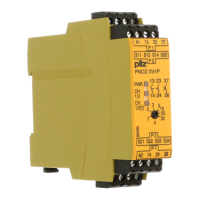PNOZ XV1P
Operating Manual PNOZ XV1P
20596-EN-07
11
Wiring
Please note:
} Information given in the "Technical details [ 16]" must be followed.
} Outputs 13-14, 23-24 are instantaneous safety contacts, output 37-38 is a delay-on de-
energisation safety contact.
} To prevent contact welding, a fuse should be connected before the output contacts (see
Technical details [ 16]).
} Calculation of the max. cable runs l
max
in the input circuit:
R
lmax
= max. overall cable resistance (see Technical details [ 16])
R
l
/km = cable resistance/km
} Use copper wire that can withstand 60/75°C.
} Sufficient fuse protection must be provided on all output contacts with capacitive and in-
ductive loads.
} Do not switch low currents using contacts that have been used previously with high cur-
rents.
} The power supply must comply with the regulations for extra low voltages with protect-
ive electrical separation (SELV, PELV) in accordance with VDE 0100, Part 410.
} Ensure the wiring and EMC requirements of IEC 60204-1 are met.
Important for detection of shorts across contacts:
As this function for detecting shorts across contacts is not failsafe, it is tested by Pilz during
the final control check. If there is a danger of exceeding the cable length, we recommend
the following test once the unit is installed:
1. Unit ready for operation (output contacts closed)
2. Short circuit the test terminals S22, S32 for detecting shorts across the inputs.
3. The unit‘s fuse must be triggered and the output contacts must open. Cable lengths in
the scale of the maximum length can delay the fuse triggering for up to 2 minutes.
4. Reset the fuse: Remove the short circuit and switch off the supply voltage for approx. 1
minute.

